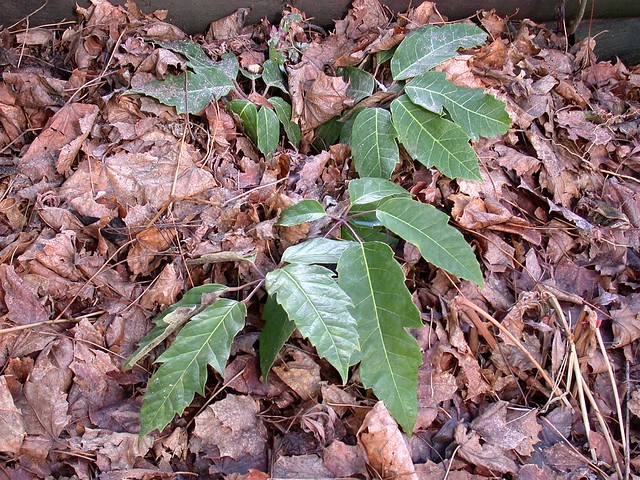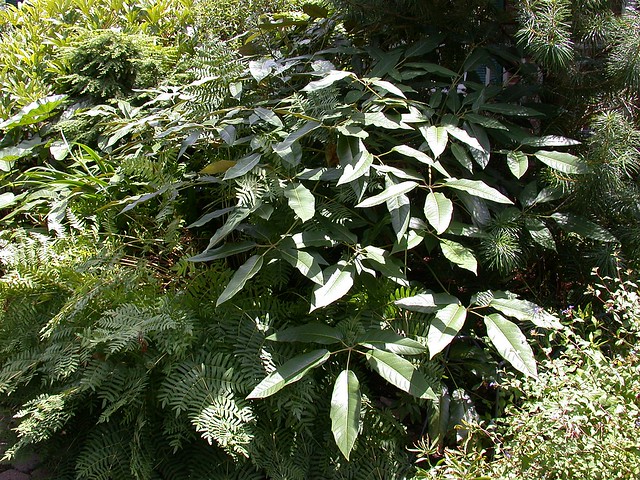
Schefflera delavayi, well-mulched for the winter
When I visited Plant Delights Nursery in Raleigh, North Carolina this past July, among several impulse purchases was a seedling of Schefflera delavayi (Araliaceae), a Fatsia relative from China with large, glossy, tropical-looking evergreen leaves. I just couldn't help myself, especially after seeing a larger specimen growing on the property

Schefflera delavayi at Plant Delights Nursery
I didn't get it planted until September, largely because I couldn't figure out where to put it (a common problem with impulse purchases!). This is on the late side for a marginally hardy plant; I generally try to get such plants in the ground in the spring to give them a full growing season to get established before winter comes. I've mulched it heavily with leaves, and if truly cold weather is in the forecast I may use the sophisticated protection method I developed to protect some of my hardy palm seedlings during their first two winters. I prefer to grow plants unprotected, but I'll make an exception for something new and unusual that isn't yet established, just to give it a fighting chance.
The Plant Delights catalog warns that this is a slow-growing species, especially in the heat of the southeastern USA. Growth is apparently faster in the cooler climate of the Pacific Northwest, where more people seem to be growing it. The catalog describes the species as hardy to "zone 7b to 9b, at least" and having survived 8 degrees without protection. The last time my garden experienced a low of 8 degrees was February 2007, so if DC winters keep up their recent warmer-than-average streak, I think my chances with it are pretty good.
The species has a wide range in southern China where it grows into a small tree, producing tiny white flowers in the fall. Schefflera delavayi (Franch.) Harms was originally described in 1896 by French botanist Adrien René Franchet as Heptapleurum delavayi, the name honoring Père Jean Marie Delavay, who collected this species in Yunnan, China in 1889. It was transferred to the genus Schefflera in 1900 by German botanist Hermann Harms and (except for a brief excursion into Agalma in 1967 that few botanists seem to have noticed) there is has remained. Ah, but for how much longer? Recent studies on this pantropical genus have revealed that it's an unnatural group and the Flora of China treatment of this genus suggests Schefflera delavayi (and all other Chinese members of this genus) will end up in some other genus.
This seems to be one of those plants that's so new that everybody is growing it. Several other bloggers have already provided some good information and photos but most of the information seems to be coming from the Pacific Northwest. Is anybody else trying this species in zone 7 on the east coast?

Scheffleras are definitely pretty hot now. Kartuz recently propagated Schefflera "Nova" and most of my friends that I've visited his nursery with have purchased it. It will be interesting to see how many other Scheffleras are going to be brought into cultivation in the future.
ReplyDeleteI hope to try one or two more species next year... assuming I can find them (and the prices come down a bit!).
DeleteHey thanks for posting to my FB page so I could find your blog! We just went through a very cold period here (12.7F) and I covered both of my Schefflera (this + S. taiwaniana) because I am a wimp. They both look great, my S. delavayi has been in the ground since early spring 2013. Growth slowed a bit when I planted it but it recovered and did well over the summer. BTW I love your "sophisticated protection method" it looks a lot like mine! http://dangergarden.blogspot.com/2013/12/protection-for-plants-or-just-something.html
ReplyDeleteSchefflera taiwaniana is definitely on my wish list for next year! A couple of people have suggested it may be hardier than S. delavayi.
DeleteJohn, I have had friends of mine who grew Schefflera delavayi in the suburbs of Philadelphia for the last six or so years without problems. The plants did flower, although I'm not sure if they produced seed. At Chanticleer, there is one mature plant of 3' that has come through the last several winters as well - it is in a protected spot. Schefflera delavayi is probably the hardiest species for Zone 6B to 7.
ReplyDeleteThanks Eric, that's very encouraging. I'll definitely post an update next year!
DeleteHave you tried the other species S. taiwaniana? I obtained Schefflera taiwaniana in the Pacific Northwest to trial at Chanticleer, but the plants are too small and will require another year or two before they're large enough to be trialed outdoors.
DeleteS. taiwaniana is the next species on my wish list! Do you work at Chanticleer? I haven't been there yet, but I keep hearing good things about it and hope to get there sometime in 2014.
DeleteI do - I handle all the curatorial responsibilities - a large task if you ask me, given how we don't use labels. I used to spend a lot of time in DC, and do come down occasionally to see my folks in MD. Keeping my fingers crossed for the Trachycarpus outside -
Delete